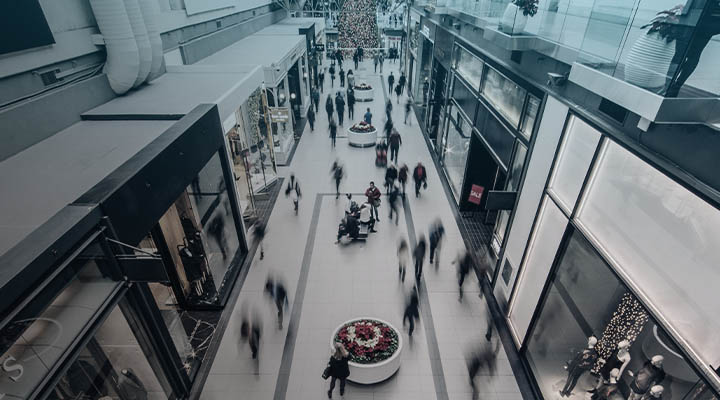Many department stores have developed shopping channels in complete silos with apps, websites and stores that offer different experiences and functionality that don’t support the end-to-end journey.
It’s not new news that department stores are seriously struggling. It’s virtually impossible to open a paper without reading about their battle to win round customers and their drastic turnaround plans. We often see many of the same reasons cited for their fall from grace; changing customer behaviour, increasing online sales and rising overheads. I don’t doubt that these are all contributing factors, however I think it’s a little more complex than the headlines suggest and having the vision and determination to turn these giants around is no mean feat. But, it is possible.
The Road to Everyone has led to No One
Customers have evolved significantly over the last decade. Their expectations are sky high, their loyalty is low, and they have access to more information about companies and products than ever before.
To add to this difficult mix, each generation has a different set of values and requires something different from their shopping experience. According to Eventbrite, more than 3 in 4 millennials would choose to spend money on an experience or event over buying something. Compare this to the grey pound segment, who value the convenience of online shopping and home delivery, spending over £15bn each year online (Greenlight).
When comparing the many well-known department stores on the high street it could be argued that they have forgotten (or don’t know) who their core customer is and, in an attempt, to survive are targeting everyone and anyone. This is leading to a confusing message for consumers and a sea of sameness on the high street, with many of our well-known department stores stocking the same products, offering identical discounts as well as the same unexciting in-store experience.
So, what should department stores do?
In my opinion, in the department store of 2019 every decision should be driven by data and identifying core and target customer groups is no exception. Every retailer should have a detailed understanding of their customer segments, including their customers’ socio-economic statuses, their values and interests, where they shop, what they buy, how price sensitive they are, communication they respond to, and channels they convert in. A retailer should then be able to accurately calculate the lifetime value of a customer, determining how much they should spend acquiring a customer, monitoring retention rates and ultimately identifying the most valuable and profitable customer groups.
This data can then be used to identify their core customers and those they should target. All business decisions should focus on these customers, from products and brands stocked, to loyalty programmes and discounts, right through to store locations and formats. Any deviation could alienate the core and target customers, whilst attracting those that are unprofitable long-term.
To learn from the best here, we should look at the understanding Hema has of its customers and about their shopping behaviour in all channels; and importantly how they use this data to market and sell to them in the most effective way to drive profitable growth.
Bricks and Clicks
The term omnichannel journey can be used, and misused, in a range of ways but it all comes down to delivering a seamless journey within and across channels.
Many department stores have developed shopping channels in complete silos with apps, websites and stores that offer different experiences and functionality that don’t support the end-to-end journey. Many also fail to understand the role their stores play as part of this journey and how they should right-size stores and update locations to avoid costly overheads and maximise returns.
Again, retailers need to turn to data to provide the answers. They need to understand how their customers move across channels, pain points they encounter and the impact this has on conversion rates and profit. This data can then be used to form an end-state vision for each channel and the journey as a whole, with associated KPIs. A prioritised transitional plan can be developed to deliver the end-state vision within time and capital constraints.
When it come to right sizing formats, Nordstrom in the US is leading the way. They are introducing small Nordstrom Local stores to act as hubs for customers to pick up and try online orders, complete returns, get style advice and socialise. These formats will support the wider omnichannel journey, place a far smaller cost burden on the balance sheet, whilst boosting trade and increasing catchment sales.
The Nike House of Innovation 000 in NYC takes omnichannel to the next level. The store is built to deliver a personal experience to customers relying heavily on an in-store app. Using the app, customers can request for products to be sent to the fitting room to try on, can shop directly from mannequins, pre-order items to pick up during their lunch break or check-out anywhere in the store. The store’s walls can also physically be moved to change the appearance of the store overnight, and there is even a floor reserved for Nike VIP customers.
Profit is Sanity
As the saying goes, turnover is vanity, profit is sanity. Department stores need to identify what’s hurting their bottom line and develop speedy tactical solutions to fix the problem. It is only through a mix of strategic and tactical projects that department stores will be able to deliver the dramatic turnaround needed to survive the next decade.
These challenges could include anything from rightsizing their vast store estate, to battling increasing staff costs, to reviewing their product mix or volumes.
We can see that fast fashion player ASOS is implementing tactical solutions to target what we can assume must be one of its biggest pain points – a high rate of returns. ASOS are using algorithms to predict which size will best fit customers based upon measurements they have provided and their previous purchases and returns history. This increases the likelihood of the products fitting, reduces return rates and results in a happier customer and a healthier margin.
What's the Bottom Line Here?
It’s crucial that department stores use hard data to develop a holistic view of their current business performance and develop a long-term strategy underpinned by several shorter-term tactical solutions to solve immediate business challenges. To achieve the best results we recommend an objective, third party assessment which can help to identify a roadmap and a number of smaller transformational steps.
Published
April 29, 2024Reading time
4 minutesRelated posts





